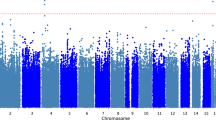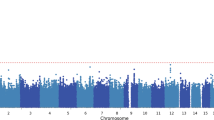Abstract
Dopamine receptor antagonism is a common mechanism underlying the therapeutic efficacy of all classical antipsychotic drugs. It is also thought to underlie the propensity of these agents to induce the movement disorder, tardive dyskinesia (TD), in one fifth of chronically exposed schizophrenia patients. We examined the polymorphic serine to glycine substitution in the first exon of the gene encoding the dopamine D3 receptor (DRD3) inn 53 schizophrenia patients with TD, 63 matched patients with similar antipsychotic exposure but no TD and 117 normal controls. There was a difference in allele frequency that was of borderline significance (P = 0.055), due to an excess of the DRD3gly allele (allele 2) in the schizophrenia patients with TD. The difference in genotype distribution among the groups was highly significant (χ2 = 19.1, d.f. 4, P = 0.0008) due to an excess of the DRD3ser-gly genotype in the schizophrenia patients with TD. The difference between the schizophrenia patients with TD and the controls was highly significant (χ2 = 19.0, d.f. 2, P = 0.00007), even after correction for multiple testing, as was the difference between the combined group of schizophrenia patients and the controls (χ2 = 12.2, d.f. 2, P = 0.002). Comparing the schizophrenia patients with and without TD, genotypes containing the gly allele (DRD3ser-gly and DRD3gly-gly genotypes combined) were significantly associated with dyskinesia (OR = 2.62, 95% CI 1.18–5.59, P = 0.02). DRD3 genotype and age at first antipsychotic treatment contributed significantly to total score on the Abnormal Involuntary Movements Scale (AIMS). The contribution of DRD3 to the variance in AIMS total was 5.2% and the total proportion of the variance accounted for by these two variables together was 11.9%. These results support and extend the report by Steen et al (1997) of an association between DRD3 and TD in schizophrenia patients.
This is a preview of subscription content, access via your institution
Access options
Subscribe to this journal
Receive 12 print issues and online access
$259.00 per year
only $21.58 per issue
Buy this article
- Purchase on Springer Link
- Instant access to full article PDF
Prices may be subject to local taxes which are calculated during checkout
Similar content being viewed by others
Author information
Authors and Affiliations
Corresponding author
Rights and permissions
About this article
Cite this article
Segman, R., Neeman, T., Heresco-Levy, U. et al. Genotypic association between the dopamine D3 receptor and tardive dyskinesia in chronic schizophrenia. Mol Psychiatry 4, 247–253 (1999). https://doi.org/10.1038/sj.mp.4000511
Received:
Revised:
Accepted:
Published:
Issue Date:
DOI: https://doi.org/10.1038/sj.mp.4000511
Keywords
This article is cited by
-
Support for association of HSPG2 with tardive dyskinesia in Caucasian populations
The Pharmacogenomics Journal (2012)
-
Pharmacogenetics and pharmacogenomics of schizophrenia: a review of last decade of research
Molecular Psychiatry (2007)
-
Serotonin and dopamine receptor gene polymorphisms and the risk of extrapyramidal side effects in perphenazine-treated schizophrenic patients
Psychopharmacology (2007)
-
A Ser9Gly Polymorphism in the Dopamine D3 Receptor Gene (DRD3) and Event-Related P300 Potentials
Neuropsychopharmacology (2006)
-
Pharmacogenetics as a tool in the therapy of schizophrenia
Pharmacy World & Science (2005)



